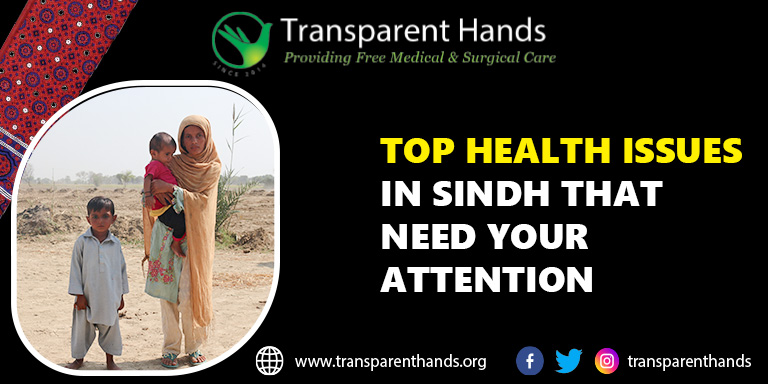Top Health Issues in Sindh That Need Your Attention

Sindh province is located in the country’s south and has a population of 47.89 million people, according to the 2017 population census. Sindh suffers from a severe lack of healthcare facilities and numerous health problems that have a negative impact on the well-being and quality of life of its residents. The effects of health issues in Sindh are felt everywhere and by everyone from farmers in rural areas to residents in urban cities.
When it comes to disasters and catastrophes, the healthcare infrastructure in Sindh is woefully inadequate. In 2013–2014, many districts were hit by the worst drought. Then, in 2022, the severe monsoon and flooding affected 23 districts. Healthcare is inaccessible to many because the roads are in bad shape and there aren’t enough doctors, nurses, and medicines. The overall health infrastructure in the province is not in a condition to provide basic treatment to the needy ones. Even though the issues in Sindh are complex and widespread, it is essential to identify them and their underlying causes in order to address them.
Top Health Issues in Sindh
- Vector-borne diseases such as malaria and dengue, acute watery diarrhea, cholera, skin diseases, and malnutrition are rising. Additionally, maternal mortality and pregnancy-related deaths are more prevalent in Sindh.
- Due to increasing temperatures, humidity, and intense heat waves, vector-borne diseases such as encephalitis, yellow fever, schistosomiasis, river blindness, and sleeping sickness tend to spread rapidly.
- Drought has also brought forward health risks like food scarcity and widespread malnutrition, leading to deficiency diseases like anemia, scurvy, and night blindness. In all eight drought-affected districts, acute malnutrition is a major public health issue. Stunting, wasting, and underweight children are common in the region.
- Sindh’s poor sanitation, water supply, and hygiene awareness make waterborne diseases like diarrhea, typhoid, and cholera common. As millions of displaced people during the floods drank floodwater, dysentery, cholera, and malaria spread.
- Water scarcity causes poor hygiene and living conditions, which spread water-borne diseases like gastroenteritis, skin infections, eye infections, acute respiratory infections, and kidney/liver diseases.
- A high incidence of communicable diseases, such as tuberculosis, malaria, and hepatitis, and non-communicable diseases, such as cardiovascular disease, diabetes, and cancer, also plague the province.
Causes of Different Health Issues in Sindh
Multiple underlying causes are contributing to the province’s multitude of health problems. Poverty, which is widespread in the province, is a major factor. Poor people struggle to afford healthcare, nutritious food, clean water, and sanitation, leaving them vulnerable to a variety of health issues. Poverty weakens the immune system, making people more vulnerable to different types of health diseases.
Inadequate healthcare infrastructure in many parts of Sindh contributes to the health crisis. Some urban areas have well-equipped hospitals and medical facilities, but rural areas often lack even the most basic healthcare amenities. Remote residents must travel far to get medical care due to a lack of infrastructure and the availability of quality healthcare. The shortage of doctors and nurses delays diagnosis and treatment, worsening the situation. This delay makes preventable diseases worse and harder to treat, burdening the healthcare system.
Solutions to the Top Health Issues in Sindh
- The government and non-governmental organizations should provide dietary supplements and educate parents on proper nutrition. In order to prevent waterborne diseases that contribute to malnutrition, they should also focus on expanding access to clean drinking water and sanitation facilities.
- The government should expand maternal health education programs and improve the availability and quality of maternal and child healthcare services.
- Through effective vector control, vaccination campaigns, and public health education programs, the government should prioritize disease prevention.
- The government should increase campaigns emphasizing the significance of a healthy lifestyle, including regular exercise and a well-balanced diet, and give regular health screenings a top priority.
- The government and non-governmental organizations should provide free medical camps in Sindh to overcome the health issues in Sindh.
Conclusion
To address these issues, the government, non-governmental organizations (NGOs), and healthcare providers must collaborate to provide effective solutions, such as increasing access to quality healthcare, promoting preventive measures, providing nutritional supplements, improving maternal and child healthcare, reducing stigma surrounding mental health, and increasing public education campaigns. The government of Sindh can improve the health and well-being of its citizens and create a healthier future for them by implementing practical and effective solutions.










Leave a Reply